Arguably, the greatest combat contribution of any Hollywood celebrity during World War II was Jimmy Stewart (as opposed to Clark Gable and his photo ops). Stewart entered the United States Army Air Force (USAAF) as a private immediately following Pearl Harbor. Already a licensed pilot, Stewart demanded to be treated as any other enlisted man and by 1943, he was a pilot in the 445th Bombardment Group. In November of that year, the 445th was assigned to RAF Tibenham air base in England. Stewart flew twenty-five missions as a commander of a bomb squadron of B-24s and twenty uncredited missions before being sent home. He was promoted to major in January 1944 and was a full-bird colonel after his service was up. Jimmy Stewart was awarded the Croix de Guerre by Gen. de Gaulle as well as two Distinguished Flying Crosses. Stewart went into the Air Force Reserves and was promoted to brigadier general (one star). On 23 May 1985, President Reagan honored Stewart with the Presidential Medal of Freedom and promoted him to major general (two stars).
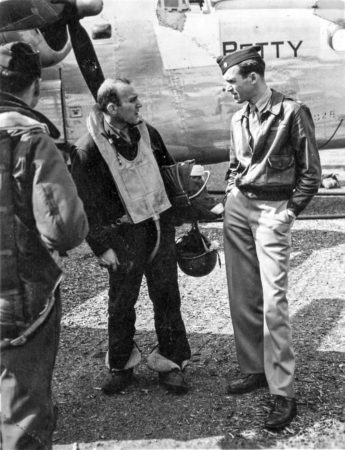
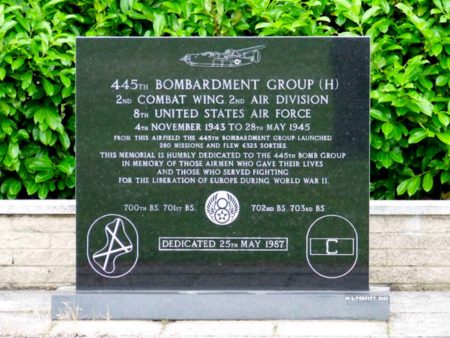
Today’s blog isn’t about Jimmy Stewart. It’s about the heavy bomber he flew: the B-24, or “Liberator.” We will highlight one plane known by its nose art as “Hot Stuff.” This blog also has a special meaning for my family. My paternal grandmother was a “Rosie the Riveter” during the war. She lived in San Diego and worked at the Consolidated Aircraft factory where B-24s were manufactured. Elsie Ross was assigned to the production line that built the wings for the B-24s. It is very likely she worked on the wings of the B-24 that would eventually be named Hot Stuff.

Did you Know?
Did you know that of the sixteen million Americans who served in World War II, only an estimated 100,000 remain alive today. The youngest is ninety-five.
Former French Resistance fighter, Hubert Germain, passed away on 12 October 2021. M. Germain was the last surviving Compagnon de la Libération (Companion of the Liberation) and a member of l’ordre de la Libération (Order of the Liberation). After a ceremony at Hôtel des Invalides on 11 November, his remains will be transferred to Fort du Mont-Valérien where internment will be in the crypt of the Mémorial de la France combattante. His final resting place will be in the seventeenth coffin reserved for the last survivor of the 1,038 companions of the liberation.
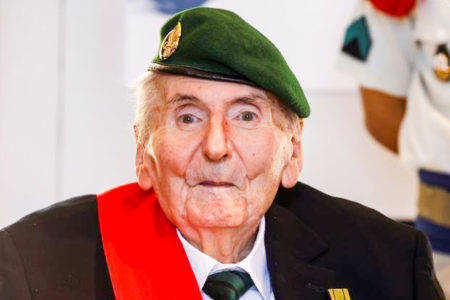
The B-24 Liberator
There were two heavy bombers used by the USAAF during World War II. One was the B-17, the “Flying Fortress” (click here to read the blog Rendezvous with the Gestapo) and the other was the B-24 nicknamed “Liberator.” (The predecessor to the Liberator was the B-25 Mitchell medium bomber.) Both planes were used in the Pacific and the European theaters with the B-24 as the preferred heavy bomber in the Pacific and the B-17 as the top choice in Europe. In addition to other bomb commands (e.g., 9th, 12th, and 15th), the 5th and 8th USAAF used the B-24 for heavy bombing missions in the Pacific and Europe, respectively. After May 1945, most of the European based B-24s were sent to the Pacific theater in anticipation of the invasion of Japan.

The United States Army Air Corps (the USAAF’s predecessor until June 1941) awarded a contract in March 1939 to Consolidated Aircraft to design and build a prototype. The XB-24 was found to be deficient in many areas and improvements were made in subsequent generations with the B-24A model first delivered to the air force in mid-1941. The primary reason the B-24 was used in the Pacific war against the Japanese was the plane had a longer range than the B-17.
The design of the B-24 was much different than the B-17 aircraft. The plane’s wingspan was six feet longer than the B-17. It enabled the plane to have a higher airspeed as well as the longer range. The tailplane was two large oval vertical stabilizers. (It was agreed that a single tail provided better stability, but only one prototype was produced before the war ended.) The B-24 featured the tricycle undercarriage. Bombs were held in two separate central bays and the plane carried the same bomb capacity as the B-17. The glazed “green house” nose was eventually replaced with a nose turret (i.e., B-24H) at about the same time the B-17F was revamped with a nose turret to prevent head-on attacks by enemy fighters. The attack planes could not fly long-range patrols and so, the B-24 did not carry the same heavy armaments as the B-17 aircraft. Like the B-17, the B-24 carried a crew of up to ten.
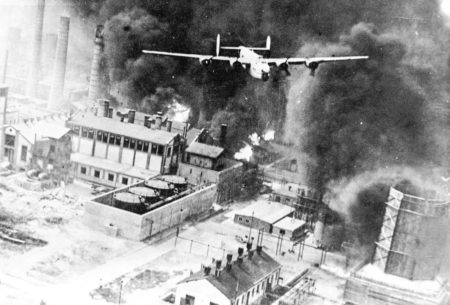
Unfortunately, despite its longer-range opportunities, the B-24 was not as safe as the B-17. The Davis wing design was susceptible to ice formation which was not good for air lift. The wings were also more prone to damage from flak, bullets, and other enemy anti-aircraft fire power. The tricycle undercarriage made taxiing difficult. Worse yet, the B-24s leaked fuel. Bomb bay doors were opened slightly to dispel potentially dangerous fumes. Smoking was never allowed while in flight. Flight crews called the B-24 a “Flying Coffin” because there was only one exit to escape a crippled plane (at the tail of the aircraft).
The Liberators were used extensively against German U-boats during the Battle of the Atlantic. They patrolled the seas for surfaced U-boats as well as providing aerial cover for the convoys. Their success in the Atlantic helped neutralize the German navy and in particular, the attacks on Allied convoys. (Click here to read the blog The Wrens.) Some of the B-24s were retrofitted to accommodate cargo and passengers and used as transport planes. Compared overall to the B-17s, the Liberators delivered less bombs to target during the war, but the B-24 bomb squadrons took lower casualties due to relatively safer missions.
Production
Split between two manufacturing companies, about 18,500 B-24s were produced across a range of different models (compared to a total of 12,731 B-17s) with the B-24J reaching thirty-six percent of total aircraft production. Near Ann Arbor, Michigan, Ford Motor Company set up the Willow Run Bomber plant and produced about 8,700 planes. It reached peak production with a plane coming off the line every fifty-nine minutes. (Production eventually outstripped air force capacity to put the planes in the air.) Consolidated Aircraft tripled its San Diego manufacturing facility and by 1942, the company employed 45,000. During the war, Consolidated built 9,251 B-24s, or fifty percent of total B-24 production. (For those of you who choose to do the arithmetic, about 550 planes were manufactured by Douglas Aircraft.) After the war, the B-24s were phased out of the air force but they went into service in other countries for a myriad of uses including transport. Many of the aircraft ended up in bomber graveyards waiting to be disassembled. Today, there are only two air worthy B-24s: the Diamond Lil, the only surviving A-model B-24 (tail no. 40-2366), was the eighteenth B-24A to come off the production line and a B-24J (Witchcraft; tail no. 44-44052) that flies in air shows around the country. Other B-24s you might see exhibited in museums or airfields are static (i.e., they don’t fly).
Nose Art
Nose art on the fuselage of a plane represented good-luck charms, morale-boosters, and many times, a reminder of the pilot’s personal life. Most important was the alluring woman who made you forget about the deadly bombs about to be unleashed on the enemy (and unfortunately, civilians). Nose art ranged from actual photographs of a pilot’s wife (Maj. Bong’s wife, Marge, on his P-38) to celebrities (e.g., Betty Grable and Rita Hayworth) to national symbols (e.g., Cross of Lorraine and the Canadian maple leaf) to the outrageous and erotic (e.g., Hot Stuff). Much of the artwork were pinups in various poses, clothed or not. Nose art was not limited to the bombers. It was featured on fighters such as the P-38, P-40, P-47, and P-51. Not all planes exhibited nose art. It cost the pilot (or crew) money to have someone paint the nose. The largest nose art was painted on a B-24J known as “The Dragon and His Tail.” Many of the men who painted nose art were not trained artists, but they certainly were talented illustrators.
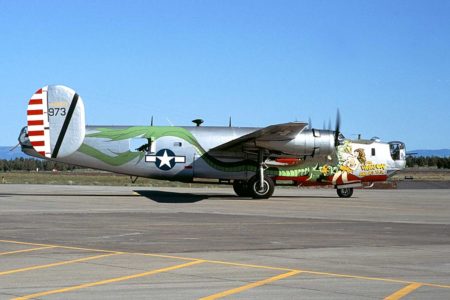
Nose art began with Italian and German pilots in the early 1900s. It was a personalized decoration based on an individual pilot’s discretion. By World War I, many aircraft exhibited nose art. In 1918, one of the American commanders ordered readily identifiable squadron insignia. The 94th Aero Squadron adorned their aircraft with the insignia that gave the squadron its famous name, the “Hat in the Ring.” Probably the most recognized nose art was the shark-face appearing on the Curtis P-40B Warhawk aircraft flown by Claire Chennault’s “Flying Tigers.” The shark-face originated in World War I by German pilots and it was used during World War II by many Allied fighter squadrons (and some German).
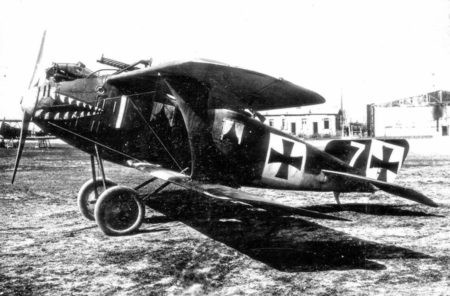
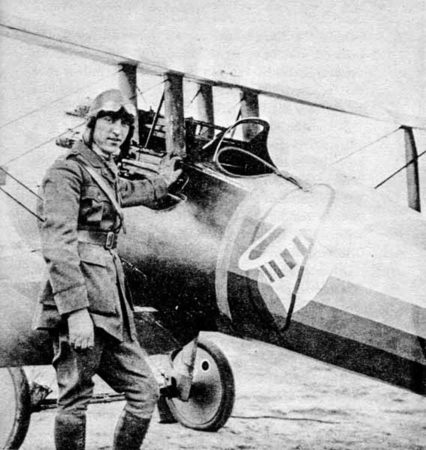
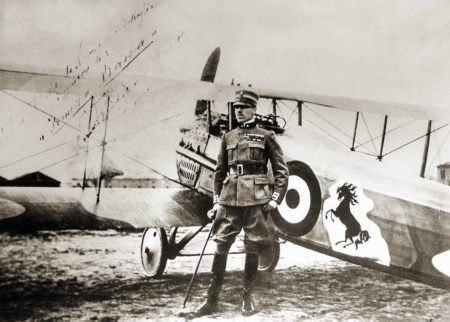
Artists such Alberto Vargas (“Vargas Girls”), Walt Disney and Warner Brothers (cartoons), and Sarkis Bartigian (B-24J known as Michigan) contributed license-free designs. Walt Disney assigned five artists to develop nose art designs. Today, nose art is seen on commercial airplanes flown by Virgin Atlantic, Frontier, and Southwest to name a few.
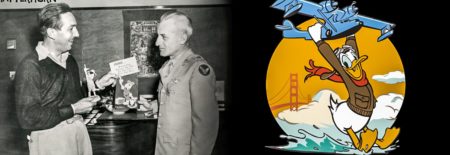
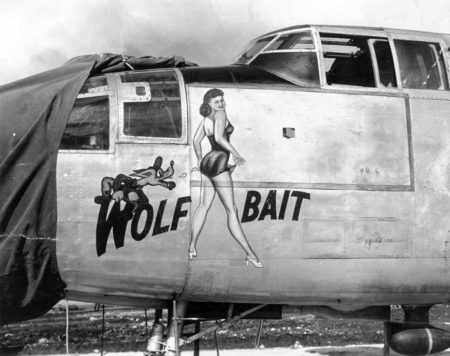
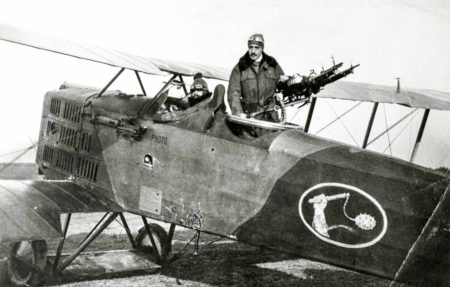
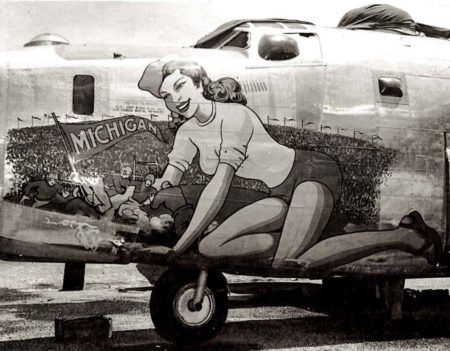
Click here to see more nose art.
Hot Stuff
A B-24D (tail no. 41-23728) nicknamed Hot Stuff was the first heavy bomber in the 8th Air Force to complete twenty-five missions in Europe (on 7 February 1943). It was based out of RAF Hardwick, England and assigned to the 93rd Bomb Group and 330th Bomb Squadron. The aircraft went on to complete six more missions before flying its last and fatal mission.
Click here to watch the video B-24 “Liberator” Part 1.
Click here to watch the video B-24 “Liberator” Part 2.
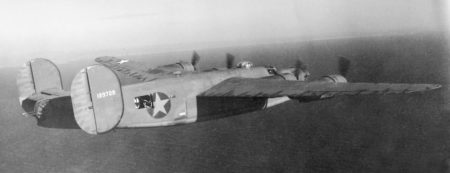
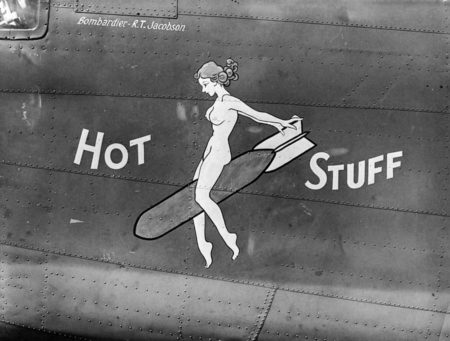
Capt. Robert (“Shine”) Shannon (1916−1943) and his crew of nine were scheduled to be part of Operation Tidal Wave (i.e., the Ploiesti raid) in early August 1943. However, Lt. Gen. Frank M. Andrews needed a ride to Washington D.C. He was scheduled to be promoted to a four-star general by Gen. George C. Marshall. Andrews chose Hot Stuff to transport him home because he knew Shannon.
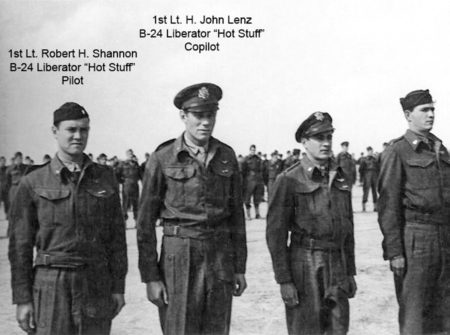
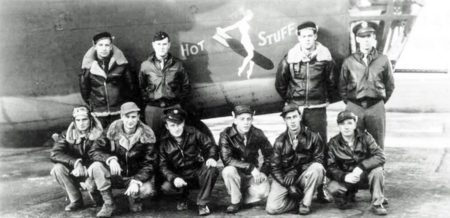
Andrews requisitioned the plane and bumped five of Shannon’s crew from the flight to accommodate the general, members of his staff, and three chaplains for a total of fifteen on board. The plane was supposed to refuel in Scotland before crossing the Atlantic, but Shannon elected to skip this stop and go on to Reykjavik, Iceland. When they got to their destination, the weather had turned ugly. Snow squalls, low clouds, and rain made it almost impossible to land. On one of its attempts to land at RAF Kaldadarnes, Hot Stuff crashed on the slope of Mount Fagradalsfjall, near Grindavik. The aircraft disintegrated upon impact. Five of the six crew were killed while Andrews and his traveling companions did not survive. The only survivor was the tail gunner, S/Sgt George Eisel (1910−1964).
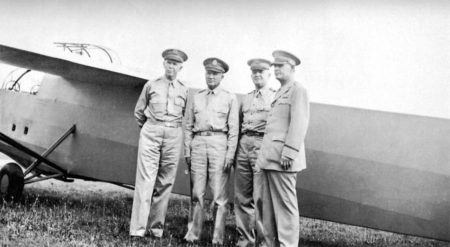
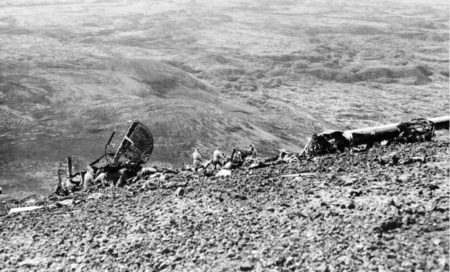
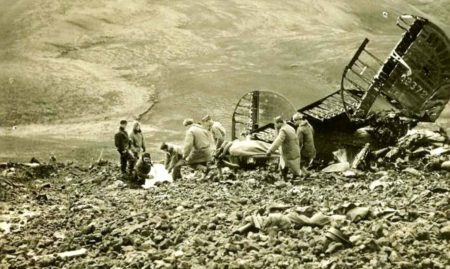
Click here to watch the video Bill Gros Radio Operator on the B-24 Liberator “Eager Beaver”.
Gen. Frank M. Andrews
Lt. Gen. Frank Andrews (1884−1943) was so important that several U.S. military installations are named after him including Joint Base Andrews (formerly, Andrews Air Force Base)⏤Air Force One is hangered at Joint Base Andrews. He was the only general to command three separate theaters of operation during World War II: Caribbean Defense Command, U.S. Army in the Middle East Command, and the European Theater of Commands Operation (his assignment at the time of the crash). The general was responsible for organizing and commanding the General Headquarters Air Force (GHQ Air Force), the first centralized command of what became the U.S. Army Air Force.
Despite all of this, Lt. Gen. Andrews is not mentioned in the same breath as that of Generals Marshall, Eisenhower, Bradley, or Patton. If Hot Stuff had made it back to the states, Andrews would have been named Supreme Allied Commander for the Allied invasion of Europe instead of Ike. If so, perhaps Lt. Gen. Andrews would have run for president in 1952?
Memorial
A memorial to Lt. Gen. Andrews, the crew of Hot Stuff, and the others killed was unveiled on 3 May 2018, seventy-five years after the crash. It is located off the highway (National Route 43) on the large plain in view of Mount Fagradalsfjall. The eight-foot monument is topped with a stainless-steel model of a B-24 Liberator.
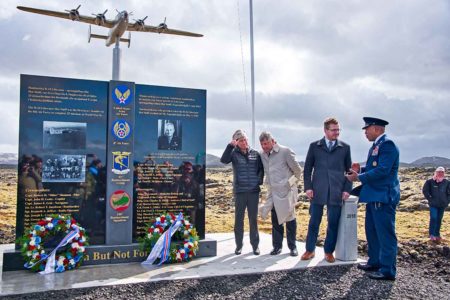
Click here to see the Stainless Steel model of the “Hot Stuff” being created.
Other Celebrity B-24 Crew Members
| Robert Altman (film director): | Co-pilot; 50 missions |
| Chuck Bednarik (NFL Hall of Famer): | Waist-gunner; 30 missions |
| Don Herbert (“Mr. Wizard”): | Pilot; 56 missions |
| Joseph P. Kennedy (JFK’s elder brother): | Pilot; killed in Operation Aphrodite |
| George McGovern (former U.S. senator): | Pilot |
| Jim Wright (former Speaker of the House): | Bombardier |
| Louis Zamperini (Olympian): | Bombardier |
★Learn More About B-24’s and “Hot Stuff”★
Ambrose, Stephen. The Wild Blue: The Men and Boys Who Flew the B-24s Over Germany 1944-1945. New York: Simon & Schuster, 2001.
American Air Museum in Britain. Click here to visit the web-site. Click here to see aircraft.
Army Air Corps Library and Museum. Click here to visit the web-site.
Hotton, Randy and Michael W.R. Davis. Willow Run (Images of Aviation). Charleston, SC: Arcadia Publishing, 2016.
Matzen, Robert. Mission: Jimmy Stewart and the Fight for Europe. Pittsburgh: GoodKnight Books, 2019.
Mullen, Cassius and Betty Byron. Before the Belle. Conneaut Lake, PA: Page Publishing: 2015.
National Archives. Click here to visit the web-site.
Snyder, Steve. Shot Down: The True Story of Pilot Howard Snyder and the Crew of the B-17 Susan Ruth. Seal Beach: Sea Breeze Publishing, 2015.
Valant, Gary M. Vintage Aircraft Nose Art. Osceola, WI: Motorbooks International, 1987 (Zenith Press⏤reprint, 2002).
I highly recommend Mr. Matzen’s book. It’s a very entertaining read about Jimmy Stewart. Mr. Snyder’s book is a very good account of the B-17s and his father’s story as a downed Allied airman in occupied-Europe. Mr. Mullen’s book tells the story of the aircraft nicknamed Hot Stuff.
Disclaimer:
There may be a chance that after we publish this particular blog, the video links associated with the blog are no longer accessible. We have no control over this. Many times, whoever posts the video has done so without the consent of the video’s owner. In some cases, it is likely that the content is deemed unsuitable by YouTube. We apologize if you have tried to access the link and you don’t get the expected results. Same goes for internet links.
What’s New With Sandy and Stew?
We are anticipate having an exciting announcement very soon about the publication of our new book, Where Did They Put the Gestapo Headquarters? The False War & Vichy (1940-1944). Volume One. In that announcement, there will be a link to the book for a special preview for all subscribers to our bi-weekly blog. We will also offer our subscribers a special opportunity to purchase the book directly from Yooper Publications (that’s us).
If you don’t want to wait for the announcement and would like to get on the pre-order list, please send Sandy an e-mail (sandy.ross@yooperpublications.com) with your mailing address.
Thank you to all of you who subscribe to our bi-weekly blogs. It seems there isn’t a day that goes by where we don’t increase our readership. Please let your history buff friends and family members know about our blog site and blogs.
Someone Is Commenting On Our Blogs
I’d like to thank Greg S. for contacting us. Greg’s father, George P. Smith, was the left waist gunner on the B-17 shot down over France after dropping its bombs on the Saint Nazaire submarine pens on 29 May 1943. He and Hilton Hilliard evaded capture until their arrest at a southern rail station. You can read about the “adventures” of Smith and Hilliard in the blog, Rendezvous with the Gestapo. I’m looking forward to further discussions with Greg.
I’d also like to thank David L. for his question about our books being available in the U.K. It’s a great question and one that I’m not sure I can answer. I know that our books are not available through Amazon in France. In fact, I can’t ship books to France⏤they get returned. As far as the U.K., we aren’t quite sure about the situation. It’s not as cut and dry as France. Sandy is looking into Amazon UK and trying to determine what the “rules” are all about. Stay tuned.
If there is a topic you’d like to see a blog written about, please don’t hesitate to contact me. I love hearing from you so keep those comments coming.
Why Would You Want to Buy Our Walking Through History Books?
Simple.
You like to travel and experience history and historical events. You like to see original buildings that had a significant impact on the people and events of the history you’re engaged with. You want to know the stories behind the brick and mortar in front of you.
The walking tour books are meticulously researched so you can go directly to those sites and learn about the building’s history as well as an introduction to some of the more interesting people associated with it.
We Need Your Help
Please tell your friends about our blog site and encourage them to visit and subscribe. Sandy and I are trying to increase our audience and we need your help through your friends and social media followers.
Thank You
Sandy and I appreciate you visiting with us. We have some exciting things on the horizon, and we’ll keep you updated as we go along.
Share This:
Follow Stew:
Find Stew’s books on Amazon and iBooks.
Please note that we do not and will not take compensation from individuals or companies mentioned or promoted in the blogs.
 Walks Through History
Walks Through History
Copyright © 2021 Stew Ross

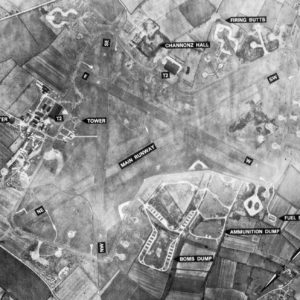
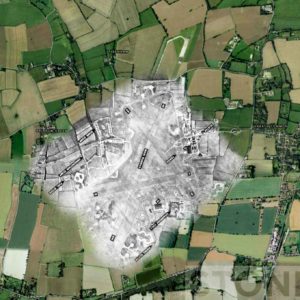
A great blog and important piece of WWII history Stew. I’m almost finished reading “MISSION” that you recommended. Jimmy Stewart’s service in the Army Air Corps as 24 Liberator Squadron Commander is truly inspiring. “SHOT DOWN” which you also recommended, answered a lot of questions I had about my own father’s Army Air Corps service as a waist-gunner aboard a B-17 that went down over Saint Nazire, France on May 29, 1943. I’ve passed this book on to a friend whose father was the ground crew chief for Paul Tibbett’s B-29 Superfortress the “Enola Gay” that dropped the atomic bomb on Hiroshima, Japan.
I look forward to reading all of your blog posts. Thanks for helping me sort out my own father’s story. He was a tight-lipped character. It’s been a very interesting experience that started for me shortly after his death in 1983. Cheers…Greg
Hi Greg; Thank you for your kind comments. Glad you enjoyed the two books I recommended. I appreciate you allowing me to tag along as you continue to uncover some truly amazing facts and images about your father’s B-17. For our readers, I wrote a blog several years ago called “Rendezvous with the Gestapo.” It’s the story of the downed Allied crew of a B-17 shot down on 29 May 1943 over northern France. Greg’s father and Hilton Hilliard were betrayed to the Gestapo and sent to Paris where they were interrogated and likely tortured. In fact, both were lucky they weren’t shot as they were dressed in civilian clothes. I’m going to include an abbreviated version of this story in the second volume of “Where Did They Put the Gestapo Headquarters?” Again, thanks Greg and I hope you enjoy the future blogs. STEW